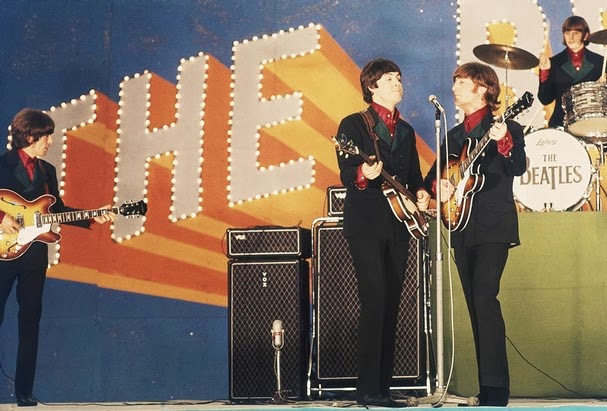 |
| With an orchestra for the Hey Jude promotional video |
Blackbird - Much the same can be said of this solo performance by McCartney. This is take 4, yet Paul recorded 32 takes before he was satisfied with the result. He plays around a bit with his phrasing, there are some variations in his guitar work and the order of the verses, but it is essentially the same song we all know from the album except that it lacks the bird sound effects and double-tracking, and it fades out.
Sexy Sadie - This is take 6 of Lennon's well-disguised rant against the Maharishi. Though the verses are complete and his singing style is the same as in the master version, it would require two remakes and many more takes before the Beatles achieved that master. The tempo here is very slow - lethargic, in fact - and John repeats one of the bridges and a few verses before the track fades out, making it a bit longer than the version on the "White Album."
While My Guitar Gently Weeps - One of the best tracks on the entire Anthology series is this sublime demo of one of Harrison's greatest compositions. George accompanies himself on acoustic guitar and gives one of the simplest and most beautiful vocal performances of his life. Paul is also present and plays some chords on an organ starting at the second bridge. And an added bonus is a final verse that was cut before the Beatles and Eric Clapton recorded the heavy, electric master version.
Hey Jude - A bit of verbal and musical banter between John and Paul (akin to what they would do throughout the Get Back sessions six months later) precedes this run-through of McCartney's majestic composition which would serve as the group's next single. John and George seem to be figuring out what to play as accompaniment at this point, but Ringo knows his role already. This early take fades out soon after the coda begins.
Not Guilty - Another standout track of the Anthology is this Harrison composition that mysteriously did not make the cut when John and Paul worked out the running order of the album, possibly due to some oblique references in the lyrics to the growing disharmony within the group, yet the Beatles had spent a few days and laid down a record 102 takes of George's tricky arrangement before arriving at this master, with the final minute containing some of the most unique and best ensemble playing they were capable of - and that is saying quite a lot.
Mother Nature's Son - Take 2 of this beautiful tune by McCartney features the composer on acoustic guitar. Like Blackbird, it would require many more takes of the basic track - 25 - before Paul felt that he had gotten it right, yet it is fully realized in this early attempt. Also like Blackbird, this would be a solo track with Paul ultimately playing all instruments except for a few brass musicians performing an arrangement by producer George Martin.









